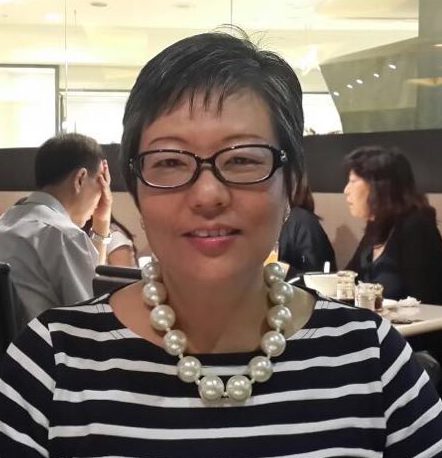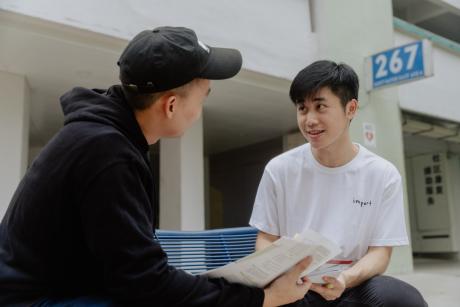By Lim Kar Yee and Ong Zhong Liang
Schools and school counsellors can only look after students while they are physically in school, and not many can do so outside of school, or are able to tackle wider problems that go beyond the child, such as if they faced challenges at home. Although school personnel occasionally pay home visits to certain pupils to explore ways of engaging them or offering assistance, it is not always easy to bridge the gap between their specific needs and the available social services in the community.

Minister Heng Swee Keat first mooted the idea on how Community Development Councils (CDCs) could play an aggregator role in bringing together wrap-around care from the community to help schools with vulnerable children. Recognising that social workers are the link between the school, family and community, a group of us and the North East Community Development Council (NE CDC) came together based on a shared vision to offer assistance to vulnerable Singaporean children. We wanted to create a future in which all kids were free to study and realise their potential, not hindered by obstacles that might keep them from pursuing a meaningful education. In particular, one of our goals is to help all high-needs/risk kids pass their Primary School Leaving Exam (PSLE).
As the African saying goes, “It takes a village to raise a child.” Similarly, addressing the needs of at-risk/needy children and their families would require a collaborative, multi-sector approach involving educationists, social workers, community developers and volunteers. We thus saw the need for a sustainable programme that would offer them targeted assistance, and the result was the North East Integrated Care Programme (ICP).
ICP: How It Works
Complementing the work of the schools and garnering community support, the North East ICP is a multi-stakeholder community development model that identifies, analyses, and matches children with needs to a variety of existing help schemes or programmes at the community. Trained school teachers and school counsellors first conduct a screening to identify students with needs, such as if they have high absenteeism at school or face family issues. The information is then relayed to the School Social Worker (SSW) and School Counsellor who will validate the identification with more detailed screening, and recommend the appropriate upstream intervention needed beginning with the student, followed by the needs of his/her family or caregivers. The recommendation is entered into a case management system where the North East CDC assesses it and refers it to the appropriate community and government partners. These include: North East CDC’s programmes like its school meal fund; Tampines West Grassroots Organisations’ YEAH! programme; character-building programmes organised by the Singapore Scout Association; Shine Youth & Children Services; Social Service Organisations; e2i/Workforce Singapore; and Family Service Centres.
Ideation and Ethos
In designing ICP, we were inspired by the “it takes a village to raise a child” mentality and “many helping hands” approach. Specifically, the programme aims to:
- Encourage upstream intervention where problems are more amenable to change and cost less than downstream intervention
- Adopt a structured collaboration (or collective impact) approach
- Develop a collaborative leadership culture
In developing a sustainable ground-up model for ICP, we began to explore the concept of a more structured collaboration framework called “collective impact” (CI), in which stakeholders from different organisations come together to create sustainable solutions and coordinate among themselves towards a shared outcome.
We also drew from McKnight and Kretzmann’s “Asset-Based Community Development” (ABCD) methodology, where a community’s strengths, resources, skills and experience are identified, and partners take joint efforts to tackle the issue.
These were appealing concepts we were keen to apply in ICP. However, we acknowledged that they could not be achieved without strong commitment from all stakeholders and closer partnerships across different sectors.
For ICP to work, there had to be collaborative leadership among the players. They had to organise themselves, assume ownership, as well as take the lead in solving complex problems. According to David Chrislip, and David Archer and Alex Cameron, collaborative leaders are people who engage collective intelligence to achieve results that cut across organisational boundaries. In other words, we believe that we are smarter, better and more creative together. The leaders also safeguard, manage and balance processes, facilitate interactions no matter how difficult, and have the patience and tenacity to deal with delays, road blocks and frustration.

ICP’s many team players—school principals, social workers, psychologists, community developers, teachers, school counsellors, IT scientists and so on—had to do just that. This diverse group of experts needed to forge strong relationships based on common values, share control and trust one another to deliver results in spite of different operating processes. Additionally, they had to contribute their skills and efforts, as well as convince their respective agencies to support their initiatives, such as through fundraising.
Instead of following a topdown hierarchical structure, every single member of the ICP Collaborative Leadership Team is a leader. Our individual team members help one another in various ways, such as by sharing donors, mediating during conflicts, and offering a safe space to have difficult conversations or respectfully challenge ideas. Above all, we share knowledge, give credit where it is due, and treat one another with openness and honesty.
All Hands on Deck
To kick off our programme, we began by identifying the schools with high-risk or high-needs students. Following that, we looked at suitable stakeholders who could commit themselves to helping these children. During our many discussions and brainstorming sessions, we aimed to design a “wraparound” style of care that would encompass children across a spectrum of needs—high, mid and low risks/needs—while acknowledging that each target group would require a different type of intervention.
In working closely with our stakeholders, we had to ensure their roles were distinct yet complementary of each other. For instance, the school principal plays an instrumental part in rallying the teachers to embark on ICP, and in providing a stable and safe environment for students. However, the principal cannot guarantee that the children will come to school every day if they face problems at home with their families or caregivers. To ensure that they do come to school—school attendance being one of the key indicators of risks/needs in children—this falls under the purview of the School Social Worker. Deployed and attached to schools by SHINE Children and Youth Services, the SSW assesses the children and their families’ needs, and identifies the suitable resources to assist them.

Thankfully we obtained the funding we needed when Trampolene came onboard. Not only did they enhance our system with Picary, we were able to scale up from one to three schools. As a result, the kids, especially those with high risk/needs, did well and all passed their PSLE that year!
Above all, we believe in continuous and closed-loop communication among all stakeholders, regular monitoring of intervention programmes, constant use of the data collected to assess and improve on our community support programmes, outcomes by the partners, and consistent enhancements to our programmes based on data we collect from Picary.
How Various Stakeholders Support Vulnerable Children
#1 North East Community Development Council (NE CDC)
Plays the role of an aggregator of information and resources, using its programmes, ground knowledge and connections with community partners to provide sustainable intervention programmes for at-risk children, their families and caregivers.
#2 Ministry of Social and Family Development (MSF)
Trains teachers and volunteers, including scouts, grassroots leaders and CDC staff in the Family and Adult Support Tool (CDC-FAST) screener to systematically identify the needs and risks (from high, moderate to low needs depending on the FAST assessment) of children. MSF also certifies them after they pass the test.
#3 Tampines West Community Club Management Committee (CCMC)
Offers low-needs kids the YEAH! programme including mentoring, sports and tuition on a daily basis, so that they can improve on their studies and have wholesome fun at the same time.
#4 SHINE Children and Youth Services (SHINE)
Provides the School Social Worker to complement the work of the School Counsellor, linking between school-social service-community support. SHINE also customises group intervention programmes to enhance their motivation and equip moderate-needs kids with skills to maximise their academic potential.
#5 Singapore Scout Association (SSA)
Aims to inculcate values and instil confidence in the high-needs children via its weekly values-driven programme called Community Scouting @ Tampines West for both at-risk and mainstream youth, as well as their families.
#6 Trampolene
Develops the case management system called Picary for school personnel, social workers, CDC officers and partners to monitor and update one another on case work (see section: "What Is Picary?").
#7Primary Schools
They are our key partners because the premise of this work radiates from the schools to the families/caregivers and finally to the community. Without the strong support and constant feedback from the school principals, this work would not have been so impactful.
#8 The CDC Plan & Develop (CPD) at the People’s Association Headquarters
Acts both as connector and facilitator of the collaboration, linking people, ideas and resources together, which otherwise will not have met or even come together. It also helps to co-create the next phase of and develop ICP, and solve problems.
What Is Picary?
The development team behind ICP is Trampolene, a research and tech-driven NPO and independent spinoff from A*STAR. Their support of S$1.27 million in the development of Picary resulted in a case management system for school personnel, social workers, CDC officers and partners.
Picary, which stands for Platform for the Integrated Care of Youths, is a case management system developed by a group of scientists and engineers from Trampolene. Before Picary, the stakeholders had to come together every month for over three hours to compareand update their case notes using Microsoft Excel.
With Picary, they can systematically update and communicate confidently and confidentially with the critical partners, as well as cut down on the duration of meetings. Picary also helps the partners to coordinate and measure their impact via a tracking and monitoring system. Leveraging the power of modern web technologies, Picary allows care providers to focus on providing better care. For example, through their interactions with the children and their families, the staff at SHINE Children and Youth Services can securely store their updates as case notes, intervention records, or quantitative surveys to track the risk factor of each child. These inputs can be further combined with updates on other interventions and referrals which are coordinated by NE CDC. When these rich inputs are connected, they help to paint a bigger picture of the progress of each student. Picary also allows for scale-ups and can be replicated in other constituencies/GRCs.
Finally, beyond merely acting as a data store, Picary provides data analytics tools to offer stakeholders more precise information about the effectiveness of each intervention.
It has been six years since we embarked on ICP, and we are excited about its growth and potential. We can now export and replicate the model, and will continue to develop the programme so as to support children beyond their primary school years. A note of thanks to Minister Masagos, Adviser to the Tampines West Grassroots Organisations, for having faith in our team and believing in us throughout the years.
Though we foresee challenges ahead, we are confident in our strong commitment towards our cause and trust among our team members. Most importantly, we will never forget that this is all for the benefit of the children.
This article was written on behalf of the ICP Collaborative Leadership Team, whose members include: Ong Lee Choo, Yao Seow Foong and Lee Siew Lian (East View Primary School); Ming Antoinette and Jenny Ho (Junyuan Primary School); Lee Tung Jean, Vivienne Ng and Karen Sik (MSF); Irene Lee (NE CDC); Ang Kai Fen, Peh Yin Yee, Melissa Lim and Wu Mei Ling (SHINE Children and Youth Services); Antong Shahrudin, Gary Lim and Tan Cheng Kiong (Singapore Scouts Association); Veronica Tay (Tampines Primary School); Russell Tham (Tampines West CCMC); Dr Victor Tong, Francis Tan, Dr Liang Huiguang and Ong Zhong Liang (Trampolene); and Yong Puay Khim and Lim Kar Yee (CPD@PAHQ).
 |
Lim Kar Yee is a Senior Director with the People’s Association, looking after the five Community Development Councils, and is a member of the Scout Council. She received an Honours degree (2nd upper) from the National University of Singapore, and an overseas scholarship for Master of Science at the University of Nottingham, UK. Kar Yee has previously worked in environmental and youth development, strategic planning, communications and publishing. She can be reached at LIM_Kar_Yee@pa.gov.sg |
 |
Ong Zhong Liang is a senior engineer at Trampolene Limited, and is the primary engineer responsible for building Picary. He received his Bachelors of Computing from the National University of Singapore in 2012. Along with working on the web application technologies powering Picary, he has also worked on programming challenges in other domains such as healthcare and machine learning. He can be reached at zhongliang.ong@trampolene.org |








Comments